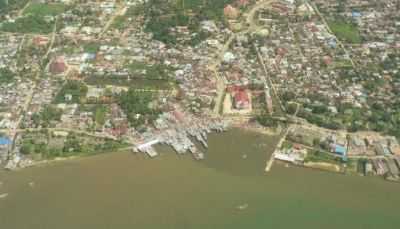
State seaport operator PT Pelindo II says it will lead a consortium to build a Rp-800 billion (US$93.6 million) container port in Sorong, West Papua.
Pelindo II president director RJ Lino said on Sunday in Jakarta that the company would work with another state seaport operator, PT Pelindo IV, and five shipping companies — PT Salam Pacific Indonesia Line, PT Samudera Indonesia Tbk., PT Meratus Line, PT Tempuran Emas and PT Tanto Intim Line — to build the port.
The consortium will sign a memorandum of understanding governing the project in July.
“We plan to start construction by early next year and expect to finish it in the middle of 2013,” he told The Jakarta Post in a telephone interview.
Lino added that the port would have an annual container handling capacity of 500,000 twenty-foot equivalent units (TEUs) and was intended to be a regional hub for the eastern part of Indonesia, linking Sorong regency with other parts of the archipelago, including Jayapura, Merauke, Bitung, Jakarta and Surabaya, as well as neighboring countries, such as Papua New Guinea and Australia.
The port would support the establishment of Papua and Maluku’s economic development corridor, one of six corridors recently launched by the government, Lino said.
“We will secure a 3,000-hectare area. The government expects to develop an industrial estate in the area and the port will support activities there,” he said.
In February, President Susilo Bambang Yudhoyono, Coordinating Economic Minister Hatta Rajasa and National Development Planning Minister Armida Alisjahbana launched an economic master plan to increase growth by 7 to 8 percent a year between 2013 and 2025.
The plan covers the development of six economic corridors throughout the archipelago, specifically in Sumatra, Java, Kalimantan, Bali and Nusa Tenggara, Sulawesi, and Papua and Maluku.
The economy in the Papua and Maluku corridor is expected to grow six-fold by 2030 under the plan, in which the development of adequate infrastructure is considered vital.
Lino said that the port would cut Papua’s logistics costs by more than 50 percent.
The Indonesian Logistics Association (ALI) chairman Zaldy Masita said that it was very expensive to ship goods to and from Papua due to limited transport capacity.
“It costs around Rp 20 million to Rp 24 million to transport goods from Java or Sumatra to Papua, or about five times the cost needed to ship goods to America,” he told the Post over the telephone.
Zaldy said that the proposed port could reduce Papua’s logistics costs as long as the volume of transported goods was increased.
“To increase the volume, the port should employ domestic ships to transport goods that are carried by foreign ships to the port from outside Indonesia to [internal] destinations — instead of letting foreign ships directly deliver the goods to Tanjung Priok Port [in Jakarta] or Tanjung Perak Port [in Surabaya], for example,” he said.
He said such arrangements would be in line with cabotage principle implemented this year, which stipulates that vessels operating in Indonesian waters must be domestically owned.
We use cookies to improve your experience. By continuing to use our site, you accept our Cookies, Privacy Policy,Terms and Conditions. Close X